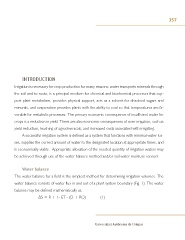Page 357 - FRUTAS DEL TRÓPICO
P. 357
357
INTRODUCTION
Irrigation is necessary for crop production for many reasons: water transports minerals through
the soil and to roots, is a principal medium for chemical and biochemical processes that sup-
port plant metabolism, provides physical support, acts as a solvent for dissolved sugars and
minerals, and evaporation provides plants with the ability to cool so that temperatures are fa-
vorable for metabolic processes. The primary economic consequence of insufficient water for
crops is a reduction in yield. There are also economic consequences of over irrigation, such as
yield reduction, leaching of agrochemicals, and increased costs associated with irrigating.
A successful irrigation system is defined as a system that functions with minimal water los-
ses, supplies the correct amount of water to the designated location at appropriate times, and
is economically viable. Appropriate allocation of the needed quantity of irrigation waters may
be achieved through use of the water balance method and/or soil water moisture sensors.
Water balance
The water balance for a field is the simplest method for determining irrigation volumes. The
water balance consists of water flux in and out of a plant system boundary (Fig. 1). The water
balance may be defined mathematically as:
ΔS = R + I - ET - (D + RO) (1)
Universidad Autónoma de Chiapas

